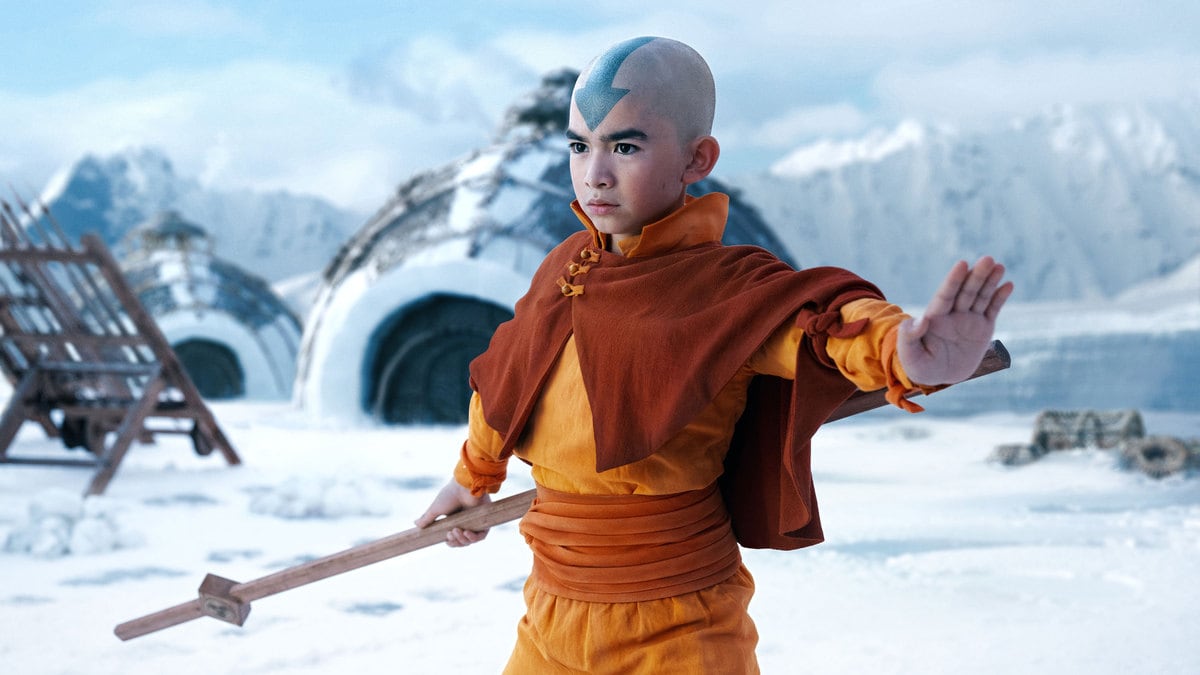In 2010, M. Night Shyamalan aimed his chest toward the masses and encouraged them to fire their missiles with his live-action adaptation of Avatar: The Last Airbender, Nickelodeon’s beloved animated series. Shyamalan’s version—simply titled The Last Airbender—was so shoddily made that it earned the director the worst reviews of his entire career. Despite its $150 million budget, a decent box office gross, and its writer-director’s characteristic ambition, The Last Airbender flopped so hard among audiences and critics that it was enough to scrap a planned live-action movie trilogy altogether.
Given all of this history, you’d think that anyone with half a clue would want to stay far away from another live-action take on the series, which ended in 2008. But put a risky venture in front of Netflix execs and ask for a palm full of money, and their answer will more often than not be, it seems, “Why the hell not?”
The streamer’s adaptation, Avatar: The Last Airbender (premiering Feb. 22), restores the series’ whole name but certainly not its full glory. While it’s far less condensed than Shyamalan’s film and with decently ambitious worldbuilding, Netflix’s version of Avatar rarely strives to differentiate itself from its predecessor. For those simply looking for a faithful spin on their favorite childhood show, this may be enough to delight the senses; the bar is, after all, pitifully low. But to an outsider, Avatar: The Last Airbender screams “adaptation,” with its rigid character archetypes and careful side-stepping of any notable or unique alterations. The show is lost in its fan service, a calculated (and occasionally impressive) effort to right Shyamalan’s 14-year-old wrong. But all that care becomes the series’ collapse, leaving it crushed under the weight of expectations, forever searching for any point to its existence.
For the uninitiated, Avatar: The Last Airbender follows the adventures of a young girl, Katara (Kiawentiio), and her dopey older brother, Sokka (Ian Ousley), after they stumble upon a boy named Aang (Gordon Cormier) who has been frozen into an ice shaft for the last century. Katara and Sokka are members of the Water Tribe, one of this fictional version of Earth’s four nations, composed of Water, Earth, Fire, and Air. In each tribe, gifted “benders” are born with the ability to telekinetically manipulate their nation’s natural elements. This, of course, resulted in unrest among the four nations. Only the Avatar—a godlike, once-in-a-generation chosen human, capable of mastering the bending of all four elements—can sow peace in this broken world. Too bad he’s been frozen solid for 100 years. That is, until Katara and Sokka free Aang from his icy purgatory.

If this is all a little difficult to keep up with, no problem. Avatar: The Last Airbender will explain the premise to you no less than four times an episode to make sure that you’re following. The series has no qualms about laying out its concepts plainly, which would be welcome if its scripts were slightly more subtle. In every other scene, a character is tasked with reminding the viewer exactly what is at stake (world peace), who the Avatar is (Aang), or what happened to Katara and Sokka’s parents (died). The original animated series did this almost as often—knowing that viewers might drop in at any second should they flip on Nickelodeon mid-episode—but with much more tact. In this live-action variant, exposition arrives clumsily at best.
This scene-setting is, however, necessary, given the massive scope and dozens of important characters. The show hops between nations and tribes with abandon, keeping it paced briskly enough to entertain viewers throughout its first season. The Fire Nation’s army fills all of these worlds, ruling over the human race and decimating land at will to exact full control, something their armies were able to do without the presence of the Avatar. But now that Aang has been thawed out and regained consciousness, that supremacy is at risk, setting Fire Lord Ozai (Daniel Dae Kim) and his son Prince Zuko (Dallas Liu) hot on Aang, Katara, and Sokka’s trail.
For a series that is so hellbent on exploring the differences between good and evil, Avatar: The Last Airbender lacks much sting. The violence and drama are limited, and when they do appear, they’re hokey and absurdly performed. Characters immolate at the Fire Lord’s will, but their deaths sound as if they accidentally got into a hot bath too fast, rather than had their bodies burnt to a crisp in screaming terror. This is technically a show for children, sure, but the animated series it spawned from didn’t shy away from terror and brutality; it just found clever ways of illustrating them without scaring kids. But this adaptation’s writers are far more preoccupied with pandering to existing fans than they are with crafting distinctive and memorable ways for the show to communicate its do-or-die stakes.
That problem isn’t helped by the show’s actors, who all do little more than recite their dialogue with striking amateurism. There’s an appropriate degree of pluckiness to this type of delivery at the show’s start, but it grates as episodes go on. It eventually becomes painfully clear that the younger actors’ novice line readings aren’t reflective of their spunky characters so much as they are evidence of their inexperience onscreen. Cormier has all of Aang’s excitable impulsiveness, but little ability to communicate more than one shade of emotion at a time, much less do so convincingly. But this is as much a fault of script as it is skill. Even seasoned actors like Kim and Ken Leung, who plays the nefarious Fire Nation commander Zhao, sound as if they’re struggling to layer their dialogue and understand their motivations in real-time.
The quality of the show’s acting is all over the map, but this can, at times, make for an amusing experience. It’s fun to watch these characters utter their wooden dialogue and look around as if they are indeed witnessing the magnificent sights of the series’ sprawling worlds, and not a room of green screens. From time to time, their efforts are even convincing. But the show always squanders this magic trick before its illusion is fully realized. Every cut corner is a reminder that this version of Avatar: The Last Airbender exists solely to sell streaming service subscriptions, not to communicate intrigue and fantasy to young viewers.

Some animation just can’t be adapted into live-action. The animated form allows a necessary level of confidence to remain present but forever invisible inside of fantastical worlds like the one in Avatar: The Last Airbender. Without that unseen, mutual trust, this series just feels goofy. In a cartoon, it’s easy to believe that all members of the Air Nomads are born bald. Here, all you see is a bunch of bald caps, forever battling against the furrowed brows of the actors that they were slapped onto.
The entire Netflix series shares that same feeling. The show is fighting to prove its worth, but is consistently hampered by lofty ambitions that could never match the original show’s scope, only surpass the previous live-action iteration. Anyone can make hopping over a bar set so low look easy. But matching—and especially exceeding—a series that is cherished and challenging takes real conviction. That’s one power that Avatar: The Last Airbender just does not have.






